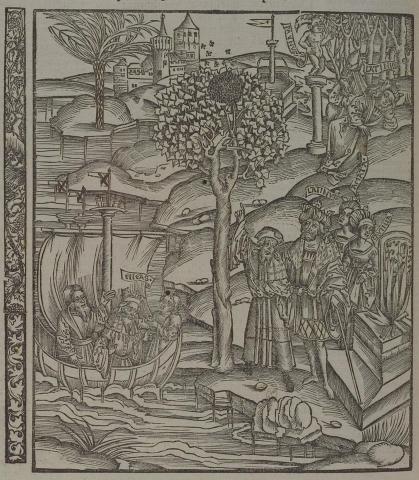Annotations
In the middle of the image, bees swarm a laurel tree, which Latinus and his wife Amata see from the lower right corner; a prophet interprets the sign, that they will be visited by a stranger with an army (59-70). They stand near an altar which is lit with a fire; their daughter Lavinia, standing between her mother and the altar, glances at the altar, a prediction of a further omen which occurs when her hair catches fire. The omen signified that she would have fame, but that she would be the cause of a war for her people (71-80). In the upper right corner, Latinus visits the oracle of Faunus, and lying on the ground on sheepskins, receives the oracle that his daughter must not marry a man of the Latin race (81-106). In the lower left corner, Aeneas's fleet pulls up to the shore along the Tiber (104-6); in the image, they are squeezed in next to the laurel tree, but in the text, they have landed in an entirely different segment of the river.
Woodcut illustration from the “Strasbourg Vergil,” edited by Sebastian Brant: Publii Virgilii Maronis Opera cum quinque vulgatis commentariis expolitissimisque figuris atque imaginibus nuper per Sebastianum Brant superadditis (Strasbourg: Johannis Grieninger, 1502), fol. 289v, executed by an anonymous engraver under the direction of Brant.


Sebastian Brant (1458-1521) was a humanist scholar of many competencies. Trained in classics and law at the University of Basel, Brant later lectured in jurisprudence there and practiced law in his native city of Strasbourg. While his satirical poem Das Narrenschiff won him considerable standing as a writer, his role in the transmission of Virgil to the Renaissance was at least as important. In 1502 he and Strasbourg printer Johannes Grüninger produced a major edition of Virgil’s works, along with Donatus’ Life and the commentaries of Servius, Landino, and Calderini, with more than two hundred woodcut illustrations. (Annabel Patterson)